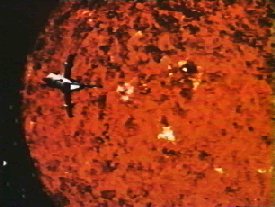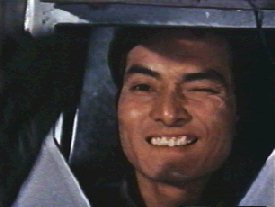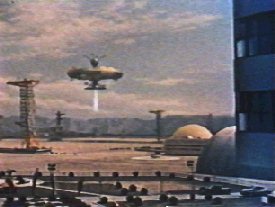Gorath (1962)
 
Gorath is a Japanese movie. Very Japanese. It was made by Toho, the studio of Godzilla, and shares quite nearly it's entire cast (and probably quite a few sets and costumes) with Godzilla vs Monster Zero. Gorath features plenty of models and special effects, and is stuffed full of melodramatic scenes, goofy spacesuits, and dialogue made disjointed by rough translation and poor dubbing. Is it any wonder that we loved it enough to give it a second lava lamp? The movie opens with the spaceship Hawk taking off to rendezvous with a stellar anomaly. The anomaly is supposed to be 6000 times the mass of Earth, so the crew of the Hawk is surprised when the anomaly, a planet dubbed Gorath for reasons unknown, is actually quite small. It's just incredibly dense, and is sucking lots of matter into it. In a somewhat surprising development, Gorath pulls the Hawk to a explosive end, prematurely ending the roles of several well-known Japanese character actors.
Tatsuo is part of the crew of Japan's backup spaceship, the Eagle (hmmm... names changed to protect the Americans?), which, after the destruction of the Hawk, is grounded due to budget concerns. From our point of view, it's silly to worry about the government's money when the Earth has a good chance of being destroyed in short order, but we guess that's why we're not holding public office. Tatsuo and his fellow crew members eventually convince the powers that be to let them launch the Eagle in hopes of stopping Gorath... somehow. No one really seems to have a plan in that regard. Fortunately, scientists on the ground do have a plan. Faced with an object 6000 time the mass of Earth, they actually come to a logical scientific conclusion. In most movies they'd try to blow up Gorath, or try to push Gorath out of its collision trajectory. But in a rare movie world acknowledgment of real world physics, the scientists in Gorath actually decide that it would be much easier to move the Earth out of Gorath's path. After all, Earth has 1/6000 the mass of Gorath, so it should be 6000 times easier to move! Using every ounce of manpower and materials at their disposal, the world governments create a network of powerful jet engines across the face of Antarctica, in the hopes that they can push Earth further along in its orbit and thus avoid destruction. We doubt that any film could satisfactorily explain such a plan and how to deal with its inherent problems, and Gorath tries only briefly. Mercifully, the film chooses instead to follow the crew of the Eagle and the populace of the Earth in their race against time.
When the special effects aren't in the fore, we're treated to the rather loopy human drama. It's all very soap opera-ish. This week on (insert organ music) As the Gorath Turns, watch as Tatsuo throws a picture of his female friend's dead fiance out a window. Watch as Tatsuo gets amnesia, and then spends what might be the Earth's final moments with a family headed by great Japanese actor Tatsuro Tamba. Tamba is playing a scientist, and needless to say, his daughter is hot. In movies, all scientists manage to bag super models, creating super-attractive children. You'd expect that eventually all this supermodel-scientist coupling would produce a race of uber-children who would rule us normal people like gods on earth, but no movie has yet tackled this provocative subject. If Gorath had better special effects, or better human interaction, we could suggest it more highly. But it isn't better than its obvious inspiration (When Worlds Collide), nor is it much better than the disaster movies like Meteor which clogged theaters in the 1970s. It does play fairly good lip service to science, though, and has the added advantage of its kinship with Godzilla films.
 Review date: 5/15/98 
This review is © copyright 1998 Chris Holland & Scott Hamilton. Blah blah blah. Please don't claim that it's yours blah blah, but feel free to e-mail it to friends, or better yet, send them the URL. To reproduce this review in another form, please contact us at guys@stomptokyo.com. Blah blah blah blah. |


